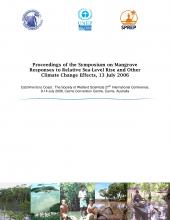Proceedings of the Symposium on Mangrove Responses to Relative Sea-level Rise and Other Climate Change Effects, 13 July 2006 Catchments to Coast. The Society of Wetland Scientists 27th International Conference, 9-14 July 2006


Climate Change Resilience, Island and Ocean Ecosystems
Available Online
Mangrove systems occur extensively on low gradient tropical shorelines, where sedimentation enables resilience during sea-level rise (SLR). Within mangroves, inundation frequencies across the intertidal slope cause zonation of different species with elevation. This tight sea-level control of the seaward margin and zones within mangroves has been demonstrated by precise EDM survey. Hence species zones in mangroves are definitive indicators of sea-level position, and pollen distributions record the locations of different zones in the sedimentary record. Pollen stratigraphic records can be used to reconstruct Holocene sea-levels and show mangrove response to change. Mangrove response to sea-level rise has been investigated in Bermuda, the Cayman Islands, Tonga and southern New Guinea. Radiocarbon dating of stratigraphy determined a sediment accretion rate of 1 mm a1for the low island locations, and up to 1.5 mm a"1 in two estuaries of southern New Guinea. The IPCC SLR projections of 9-88 cm by 2100 equate to a rate of 0.9-8.8 mm a"1. Mangrove recession events and replacement by lagoon environments are shown to occur during more rapid sea-level rise. In Bermuda rates of SLR exceed 2 mm a1and the largest mangrove area having existed for the last 2000 years lost 26% area in retreat of its seaward edge during the last century. In Tonga, a large mangrove swamp persisted 7000-5500 yr BP during SLR of 1.2 mm a1, then retreated when the rate increased. In Cayman 20 km of mangroves died back between 4080 and 3230 yr BP, during SLR of 2.8-3.3 mm a1, to become a lagoon. In extensive swamps of southern New Guinea gradual Late Holocene retreat of mangrove zones occurred with SLR of 0.67 mm a1. Hence while low island mangroves are likely to be the most sensitive to projected SLR, continental margin mangroves will also suffer disruption and retreat.

